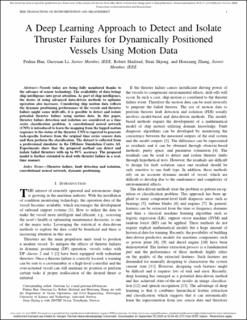| dc.contributor.author | Han, Peihua | |
| dc.contributor.author | Li, Guoyuan | |
| dc.contributor.author | Skulstad, Robert | |
| dc.contributor.author | Skjong, Stian | |
| dc.contributor.author | Zhang, Houxiang | |
| dc.date.accessioned | 2021-03-29T08:20:03Z | |
| dc.date.available | 2021-03-29T08:20:03Z | |
| dc.date.created | 2020-09-02T12:52:24Z | |
| dc.date.issued | 2020 | |
| dc.identifier.issn | 0018-9456 | |
| dc.identifier.uri | https://hdl.handle.net/11250/2735853 | |
| dc.description.abstract | Vessels today are being fully monitored, thanks to the advance of sensor technology. The availability of data brings ship intelligence into great attention. As part of ship intelligence, the desire of using advanced data-driven methods to optimize operation also increases. Considering ship motion data reflects the dynamic positioning performance of the vessels and thruster failure might cause drift-offs, it is possible to detect and isolate potential thruster failure using motion data. In this article, thruster failure detection and isolation are considered as a time-series classification problem. A convolutional neural network (CNN) is introduced to learn the mapping from the logged motion sequence to the status of the thruster. CNN is expected to generate task-specific features from the original time series sensors data and then perform the classification. The data set is collected from a professional simulator in the Offshore Simulation Center AS. Experiments show that the proposed method can detect and isolate failed thrusters with up to 95% accuracy. The proposed model is further extended to deal with thruster failure in a real-time manner. | en_US |
| dc.language.iso | eng | en_US |
| dc.publisher | Institute of Electrical and Electronics Engineers (IEEE) | en_US |
| dc.relation.uri | https://ieeexplore.ieee.org/document/9166553 | |
| dc.title | A Deep Learning Approach to Detect and Isolate Thruster Failures for Dynamically Positioned Vessels Using Motion Data | en_US |
| dc.type | Peer reviewed | en_US |
| dc.type | Journal article | en_US |
| dc.description.version | acceptedVersion | en_US |
| dc.source.journal | IEEE Transactions on Instrumentation and Measurement | en_US |
| dc.identifier.doi | https://doi.org/10.1109/TIM.2020.3016413 | |
| dc.identifier.cristin | 1826727 | |
| dc.relation.project | Norges forskningsråd: 28073 | en_US |
| dc.description.localcode | © 2020 IEEE. Personal use of this material is permitted. Permission from IEEE must be obtained for all other uses, in any current or future media, including reprinting/republishing this material for advertising or promotional purposes, creating new collective works, for resale or redistribution to servers or lists, or reuse of any copyrighted component of this work in other works. | en_US |
| cristin.ispublished | true | |
| cristin.fulltext | postprint | |
| cristin.qualitycode | 1 | |
